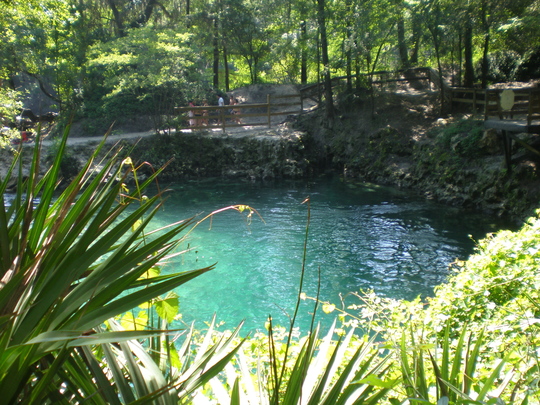FOR IMMEDIATE RELEASE: April 2, 2014
APRIL DECLARED AS SPRINGS PROTECTION AWARENESS MONTH
~April recognized as the month to encourage protecting springs in the state of Florida~

The Madison Blue Spring is located east of Madison on the west bank of the Withlacoochee River.
TALLAHASSEE – The Florida Department of Environmental Protection recognizes April as Springs Protection Awareness Month. This serves as a time to appreciate how essential springs are to the environment, economy and residents.
Several Water Management District governing boards have passed their own proclamations in support of Springs Protection Awareness Month. In addition, the Florida House has adopted a resolution and the corresponding Senate version has been filed. These resolutions declare April as Springs Protection Awareness Month.
“Florida’s springs are one of our most fascinating geological treasures," said DEP Secretary Herschel T. Vinyard Jr. “The health of Florida’s many springs is directly related to our actions, and this month is dedicated to encouraging residents and visitors to help conserve our springs.”
Florida has hundreds of documented and undocumented springs, which are fed by aquifers throughout the state. The clean and clear flowing water from aquifers at a constant temperature are essential to supporting the variety of life that is found in and around the springs. These springs also reflect the groundwater conditions, which 93 percent of Florida residents rely on for their drinking water supply.
“With more than 300 documented springs, our District is aptly called the Springs Heartland,” said Suwannee River Water Management District Executive Director Ann Shortelle. “The health of our springs is essential to our economy, tourism, and the environment, and the District has demonstrated its commitment to protecting these natural resources by designating significant funding for springs projects over the last two years.”
Healthy springs reflect the state’s commitment to sustainable ground and surface water resource protection. Governor Scott dedicated $10 million in 2013 that was expanded into more than $37 million by state, regional and local partners and invested into ten spring improvement projects statewide. These projects aim to improve water quality and quantity at several springs, and protect these important natural resources. This year, Governor Scott has allocated an additional $55 million in his “It’s Your Money” Tax Cut Budget for springs protection.
Furthermore, the Florida Park Service has installed new interpretative kiosks at each of the 20 state parks with freshwater springs. The panels share information about the threats to springs – groundwater pollution, erosion and invasive plants – and what visitors can do to reduce that threat. The kiosk provides the opportunity to touch and learn about limestone, the building block of the Floridan Aquifer and the springs.
In addition to the efforts of the Department and Water Management Districts, here are some tips for what you can do to help protect springs throughout the year:
Landscaping and lawn care tips:
- Resist the temptation to over-fertilize. Applying twice as much as fertilizer as is recommended does not make plants grow twice as fast.
- Do not over-water your lawn. Use a rain gauge to determine when and if you need to water.
- Use rain barrels to capture and store rainwater to water plants.
Indoor water use:
- Install aerators on all household faucets; they slow the flow of water.
- Re-use water. Catch water while you shower and use it to water plants. Try the same technique when washing vegetables or rinsing dishes.
- Ensure that your septic tank and drain field are properly maintained.
When visiting a spring:
- Avoid trampling underwater vegetation and stirring sediments when tubing, snorkeling, or swimming at springs.
- Use extreme caution when boating and anchoring in spring runs. Anchors, props and boat groundings can destroy aquatic vegetation and increase the cloudiness of the water.
- Dispose of your trash properly. Cans and bottles, cigarette butts, plastic bags and other trash harm water quality and wildlife and destroy the natural beauty of the springs.
|